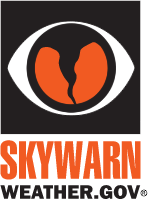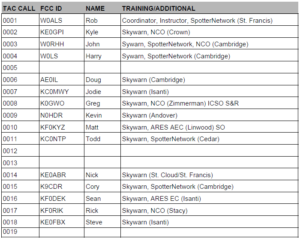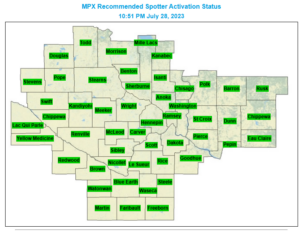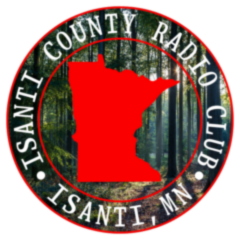
The National Weather Service encourages anyone with an interest in public service to join the SKYWARN® program. Volunteers include police and fire personnel, dispatchers, EMS workers, public utility workers and other concerned private citizens. Individuals affiliated with hospitals, schools, churches and nursing homes or who have a responsibility for protecting others are encouraged to become a spotter. Go here for more information: https://www.weather.gov/SKYWARN
We are always looking for local spotters. Please contact us at skywarn@isantiradio.org

NWS Skywarn Spotter Activation Map
 NWS Twin Cities – Local Spotter Activation Status (weather.gov)
NWS Twin Cities – Local Spotter Activation Status (weather.gov)
SKYWARN NET PREAMBLE:
Spotter Reporting Tips:
Giving Your Report
When you have a report of severe weather to pass to the National Weather Service, tune to your local SKYWARN Repeater and check in to the SKYWARN net. If you do not hear any activity on the repeater, call for “SKYWARN Net Control” and wait to be recognized.
Giving a Good Report
Giving an effective report is critical to the efficient operation of a SKYWARN net. Please review the information and sample report exchange below.
- The most important things to remember about participating in a SKYWARN net:
- STAY SAFE! Do not put yourself in harm’s way, and do not jeopardize your safety for the sake of contributing anything to SKYWARN!
- Make your report as complete as possible while keeping the transmission brief. In other words, avoid long-winded dialog with Net Control or engaging in any communication not related to your report.
- Please try to be sure your report meets severe criteria. See the Reporting Criteria, which will be periodically announced by Net Control.
Report Content
When giving your report, whether in an informal or directed net, your transmission should include the following:
- Your call sign.
- Let us know if you are a Trained Spotter. We do not need your Spotter ID.
- What’s happening – give your report – be accurate, do not embellish your report.
- The location where the incident occurred or is occurring – be specific and give the location relative to well-known landmarks, towns, or intersections.
- Indicate whether the information reported is MEASURED or ESTIMATED – very important!
- WHEN the event happened – give a SPECIFIC TIME to Net Control (“now” or “7:15 pm”) – again, indicate whether this is the actual measured time or if it is estimated.
- Where the report came from – did YOU observe it yourself, or was it passed by a third party? Who? Are they a trained spotter?
Additional Spotter Reporting Tips
- Pass your traffic clearly.
- Stay on topic.
- Repeat key figures if necessary.
- Phonetically spell lesser-known town or road names.
- If you aren’t sure where you are, as a last resort we can accept GPS coordinates in decimal format only.
- When your report is complete, wait for confirmation from Net Control. Net Control will read the report back to you. Listen carefully to ensure all the information was copied correctly. If Net Control needs you to repeat something, such a request will be made.
